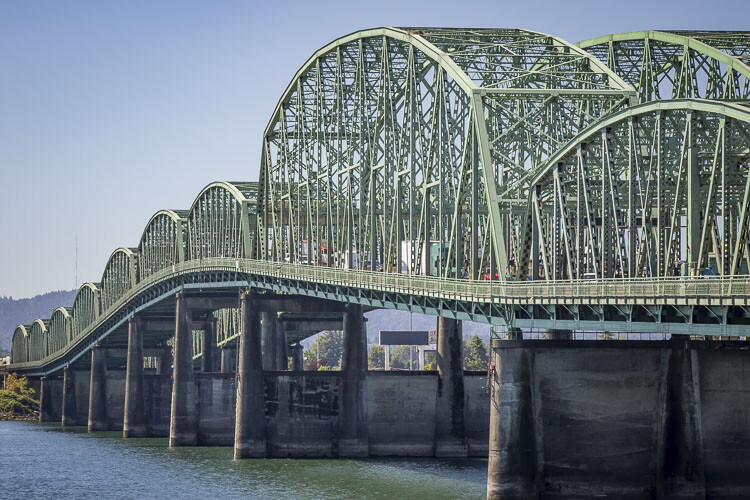
Editor Ken Vance shares changes to elements of the proposed project that he believes many Southwest Washington residents would support
Ken Vance, editor
Clark County Today
For many Clark County citizens, support of a replacement project for the I-5 Bridge comes down to two elements in the Interstate Bridge Replacement Program’s (IBR) Locally Preferred Alternative (LPA) that I object to. Those are the choice of light rail as the transit element of the project and the use of tolls to help pay for it.

There are many, many other elements of the proposed project that still face scrutiny by members of the public, community leaders and elected officials but for the sake of this discussion, I’m going to focus on light rail and tolling.
I believe it is important to point out that when a public vote was held about extending TriMet MAX light rail across the Columbia River into Clark County in 2012, a majority of voters in every city in Clark County, including Vancouver, rejected the C-TRAN ballot proposition. Again in 2013, voters supported a vote on light rail prior to any funds being spent on it, even though a county-wide vote was never held. I wish I could share more recent proof, but it is my belief that a majority of Clark County residents still oppose light rail.
When it comes to tolling, I don’t think it’s much of a leap for most of us to think that a majority of drivers would prefer to continue to not pay tolls to drive on roads or cross bridges that currently are not tolled. One anecdotal note to support that theory is that in 2017-2018, the Oregon Department of Transportation (ODOT) put together a Value Pricing Policy Advisory Committee. During that process, ODOT officials informed the members of the committee that 50,000 drivers were currently leaving the highways and traveling on side roads due to a lack of vehicle capacity. If tolling were to be implemented on Portland’s highways, ODOT officials estimated an additional 80,000 drivers would divert to the side streets to avoid paying tolls. Add to that the fact that in May, Oregon Gov. Tina Kotek and the Oregon Legislature recognized that ODOT needed to slow down on its tolling plans, in large part to resistance from the public. As a result, tolls will not be collected until 2026 and a new legislative subcommittee on Transportation Planning has been formed
When the IBR team announced details of its LPA in April 2022, it was revealed that the transit component of the project would be an extension of TriMet’s MAX light rail line across the new bridge and into downtown Vancouver. Since that announcement, the IBR team has provided cost estimates that indicate the light rail element of the project will cost as much as $1.99 billion. Total price of the project is expected to be between $6 billion and $7.5 billion. The IBR team reports that it hopes to get between $900 million and $1.2 billion from the Federal Transit Administration (FTA), which would leave the project with a funding shortfall of as much as $1.1 billion for the light rail component. Ironically, that is eerily close to the $1.25 billion the IBR team hopes to raise by tolling travelers, including the 75,000 or so Southwest Washington residents who commute to Oregon for work.
Let’s eliminate both elements with one decision
I have never said that I oppose a project that would replace the I-5 Bridge. I do, however, oppose any project that includes tolls and an extension of TriMet;s MAX light rail into Vancouver. It is my preference that we focus on creating a third crossing and corridor over the Columbia River first and then move on to the replacement of the I-5 Bridge after that. But, many disagree with me, believing there is greater urgency in replacing the I-5 Bridge so that a significant seismic event doesn’t cause it to crumble into the water below.
So, for the sake of this discussion, let’s continue to focus on the current project. I believe it would please a majority of Southwest Washington residents if the light rail component of the current project was replaced with Bus Rapid Transit (BRT). C-TRAN is currently working on its third BRT project in Clark County. The cost of each of those projects has been roughly $50 million, far less than the (as high as) $1.99 billion price tag of the proposed light rail element of the current I-5 Bridge replacement project.
I confess I’m not a transit expert. But, transit ridership across the Columbia River continues to hover below pre-pandemic numbers. An estimated 1,000 citizens currently use transit to cross the border each day. I understand, as a community, it is important that we serve those citizens and their dependency on transit. But, wouldn’t it be more efficient to do so with millions of dollars rather than billions?
Obviously, C-TRAN officials have devoted a great deal of time, effort and energy into their BRT projects. C-TRAN CEO Shawn Donaghy supports the light rail element currently proposed in the I-5 Bridge replacement project. However, Donaghy recently told area legislators that federal transit officials are big supporters of BRT projects and he elaborated on those comments in an email exchange with Clark County Today.
“During a recent discussion with some SW Washington legislators, the subject of C-TRAN’s Mill Plain BRT project came up and I shared with the group that the FTA was/is a big supporter of this project,’’ Donaghy wrote in his email response to me. “FTA is funding many BRT projects across the nation in part because they typically cost less and provide more flexibility compared to other modes. In fact, at C-TRAN’s groundbreaking event for Mill Plain BRT, it was noted by FTA and others that BRT has created a great opportunity for Clark County and they see this as a key part of our continued growth into the future.
“While the FTA certainly supports all modes of transit, there continues to be strong funding support for BRT projects across the country in areas where there may not be population densities and land use that supports other high capacity transit modes like light rail,’’ Donaghy wrote. “This is not the case as it relates to the IBR project, given the existing light rail network in Portland that will be extended just across the Columbia River to Evergreen.
“C-TRAN’s long-range plan is based on a BRT system throughout the Clark County, but as we have communicated related to the IBR project and C-TRAN’s approval of the MLPA last year, extending LRT to Evergreen is the best location for our transit systems to connect while providing another high capacity option for our residents to use who need to travel into Portland,’’ Donaghy added.
I respect Donaghy. He’s a transit guy and I’m not. Reasonable people can respectfully agree to disagree. We’re not going to see eye-to-eye on every transit project. So, it’s his belief that light rail is the best project for the I-5 Bridge replacement. I, however, do not share that belief and I think there is ample evidence to suggest a majority of citizens agree with me.
As a result, I call on our elected officials and community leaders to join a great number of Southwest Washington residents in calling for C-TRAN’s Bus Rapid Transit to replace TriMet’s MAX light rail on the I-5 Bridge replacement project. It would trim the overall cost of the project by as much as $2 billion while also eliminating the need for tolls on the new bridge.
Also read:
- Opinion: OIC tells consumers not to pay for ‘insurance’ you won’t likely benefit from: Does that include WA Cares?Elizabeth New (Hovde) of the Washington Policy Center believes you should consider yourself warned by the Office of the Insurance Commissioner about WA Cares and its maybe-only benefit.
- Opinion: Same road, different speed limit?Target Zero Manager Doug Dahl addresses a question about speed limit signs going into and leaving town.
- Opinion: Hiding the growing cost of the Interstate Bridge replacementJoe Cortright of the City Observatory addresses the rising cost of the Interstate 5 Bridge replacement project.
- Letter: ‘This election I am NOT voting for Greg Cheney’Clark County resident Wynn Grcich shares her thoughts on Rep. Greg Cheney and the issue of fluoridation in area drinking water.
- POLL: Should biological males who identify as females be allowed to compete in athletic events against biological females?Should biological males who identify as females be allowed to compete in athletic events against biological females?
Also read:
- Opinion: Hiding the growing cost of the Interstate Bridge replacementJoe Cortright of the City Observatory addresses the rising cost of the Interstate 5 Bridge replacement project.
- 90 minutes of delay on Southbound I-5 in Southwest Washington on Friday afternoon, July 26Travelers using southbound Interstate 5 through Woodland should expect up to 90 minutes of delay during Friday afternoon and evening and should delay travel or prepare for additional travel time.
- Nighttime paving work on I-5 and SR 14 in Clark County July 28-Aug. 9Nighttime travelers in Clark County should expect delays for maintenance and paving work beginning Sunday, July 28 until the morning of Friday, Aug. 9.
- Northeast 182nd Avenue/Northeast Ward Road to be closed on Aug. 1Northeast 182nd Avenue and Northeast 172nd Avenue in Clark County will have single-day closures on August 1 and August 5 for road preservation, with detours in place.
- Interstate Bridge Replacement program awarded $1.499 billion FHWA Bridge Investment Program grantInterstate Bridge Replacement program officials have shared that the program received $1.499 billion through the Federal Highway Administration’s Bridge Investment Program.














